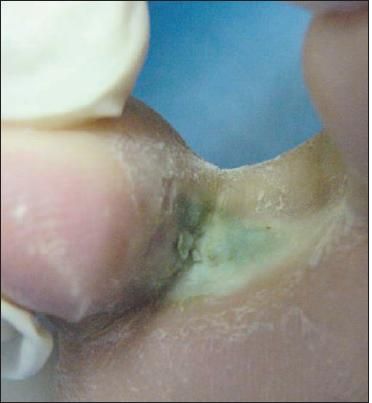Recognizing Bacterial Foot Infections
The biomechanical complexities of the foot and the circumstances that cause infections can make foot infections difficult to manage.1 When an otherwise healthy patient presents with a foot infection, a traumatic process usually is involved and treatment is relatively straightforward. Sometimes a more serious condition is the cause. The more common presentation, however, is a patient who is immunosuppressed or who has a metabolic or peripheral vascular defect that complicates treatment of the infection.
The biomechanical complexities of the foot and the circumstances that cause infections can make foot infections difficult to manage.1 When an otherwise healthy patient presents with a foot infection, a traumatic process usually is involved and treatment is relatively straightforward. Sometimes a more serious condition is the cause. The more common presentation, however, is a patient who is immunosuppressed or who has a metabolic or peripheral vascular defect that complicates treatment of the infection.
Diabetes-related infections
Foot infections cause considerable morbidity in patients who have diabetes. Prompt recognition and appropriate management can help prevent infection-related morbidity, obviate the need for hospitalization or shorten the duration of hospitalization, and reduce the risk of limb amputation.2
General risk factors for diabetes-related foot ulceration are diabetes for more than 10 years; male sex; poor glucose control; and presence of cardiovascular, retinal, or renal complications. Specific risk factors include peripheral motor, sensory, or autonomic neuropathy; peripheral vascular disease; hyperglycemia; other disabilities, such as vision deficits, previous amputations, and difficulty in mobility; and patient neglect of routine precautionary procedures, such as use of protective footwear, adherence to medical care, and inspection of the extremities. An example of a necrotic foot ulcer in a patient with diabetes is shown in Figure 1.

Figure 1 - This left forefoot ulcer with a white necrotic base developed in a patientwith diabetes. (From Strauss MB. Diabetic foot problems: keys to prompt, aggressivetherapy. Consultant. 2002;42:81-93.)

Figure
The evaluation of foot infections in patients with diabetes requires a careful physical examination.2 Culture of a wound specimen; a probe-to-bone test; and imaging studies, such as plain radiography and MRI, should be performed when indicated. Patients with radiographic evidence of osteomyelitis, regardless of the condition of the overlying skin, should have surgical consultation to obtain culture and biopsy samples and to remove any affected bone if necessary.
If possible, antimicrobial therapy should be based on culture results.2 Empiric antimicrobial therapy for superficial infections should cover Staphylococcus aureus and β-hemolytic streptococci. For moderate to severe infections, broad antimicrobial coverage should include Gram-positive cocci, Gram-negative bacilli, and anaerobes. Patients with persistent draining ulcers despite appropriate antimicrobial therapy should be evaluated for osteomyelitis and for retained infected or necrotic tissue.
Immunosuppression significantly impairs healing of foot ulcers and eradication of infection. In patients with diabetes who are immunosuppressed because of kidney or pancreas transplants, the rate of limb amputation is higher.3 In the short term, the rate of amputation in patients with diabetes who have had a kidney transplant is at least 15%.4 For 10-year survivors, the rate of amputation increases to about 33%.
Bacterial infections
Sometimes seemingly harmless injuries, such as a blister, can evolve into more serious conditions. The following case vignettes demonstrate that even immunocompetent patients are susceptible to bacterial infections of the foot. However, these infections are generally more responsive to treatment and less severe than similar infections in immunocompromised patients.
Case 1. An otherwise healthy 8-year-old boy presented with what his mother thought was a fungal infection. On physical examination, malodorous, nontender plaque formations on the weight-bearing surfaces of both feet were noted. Round pits and furrows were evident within the plaques (Figure 2). Pitted keratolysis was diagnosed. Treatment with topical erythromycin led to a rapid clearing of the lesions.

Figure 2 - The malodorous,nontender plaque formationseen here was caused bypitted keratolysis, a relativelycommon bacterial infection.(Case and photograph fromOhashi D, Courreg ML,Crane J. Photoclinic: pittedkeratolysis. Consultant.1992;32[10]:86.)
Pitted keratolysis is a relatively common bacterial infection, and its unique appearance facilitates clinical diagnosis. It is caused by Corynebacterium, Dermatophilus congolensis, or Micrococcus sedentarius. Topical erythromycin, clindamycin, or benzoyl peroxide are all effective treatments.
Case 2.A31-year-old man presented with asymptomatic, malodorous discoloration of the toe web spaces. Extensive maceration and a green tinge between the toes were also noted (Figure 3). The patient reported that his feet perspire heavily in the boots that his work requires him to wear.

Figure 3 - This foot intertrigowas caused by Pseudomonasaeruginosa and Morganellamorganii. The infectionresulted from heavy footperspiration from work boots.(Case and photographfrom Nahm WK, Pabby A,Laws R. Photoclinic: footintertrigo caused by Gramnegativebacteria. Consultant.2005;45:405.)
Adiagnosis of foot intertrigo was made after the results of a bacterial culture were positive for Pseudomonas aeruginosa, Morganella morganii, and normal skin flora. The clinical presentation of foot intertrigo ranges from a chronic, macerated, desquamative dermatitis to an acute, painful, exudative, highly inflammatory process associated with cellulitis.5 Foot intertrigo is caused typically by yeasts and dermatophytes6 and less often by Gram-negative bacteria. The green tinge was caused by pyocyanin and fluorescein, which P aeruginosa produce.
Because this infection was superficial, treatment consisted of foot soaks in a 1.5% sodium hypochlorite solution for 20 minutes each day for 7 days. The symptoms resolved within a week, and the patient was advised to keep his feet dry by using gauze pledgets between the toes, powder, and astringent soaps and by wearing open-toed shoes whenever possible. More serious infections may require systemic antibiotic therapy with Gram-negative coverage. Antibiotic resistance may complicate the treatment of polymicrobial and especially P aeruginosa infections.7
Case 3. After having had unprotected sex, an otherwise healthy 17-year-old girl reported having lower abdominal pain. A diagnosis of vaginal trichomoniasis was made, and metronidazole was given for 8 days; the symptoms resolved. One week later, joint pain and skin lesions developed. Three weeks after the original diagnosis, the patient was admitted to the hospital with night sweats, fever, and a rash.
About 20 nontender pustules were noted on the patient's hands, wrists, buttocks, and feet. Newly erupted lesions were seen on the soles (Figure 4); the patient had applied skin cream to an early pustule on the left sole. The left foot and knee joints and the right ankle joint also were tender. The white blood cell count was 10,560/& mu;L.

Figure 4 - The nontenderpustules on the soles ofthis patient's feet werecaused by disseminatedgonococcemia. (Case andphotograph from Travis L,Glick S, Lowenstein E.Photo essay: disseminatedgonococcal infection.Consultant. 2005;45:1451-1452.)
A clinical diagnosis of disseminated gonococcemia, or gonococcal arthritis-dermatitis syndrome, was made. Subsequently, blood and cervical cultures grew Neisseria gonorrhoeae on Thayer-Martin and chocolate agar media. Intravenous ceftriaxone, 1 g qd, and oral doxycycline, 100 mg q12h, were given. Her symptoms resolved within 48 hours.
The recommended treatment of disseminated gonococcemia is intravenous ceftriaxone for 2 or 3 days followed by an oral antibiotic, such as cefixime or ciprofloxacin- for a total of 1 week of treatment. Alternative regimens are available for patients who are allergic tothese agents. Symptoms typically resolve within 24 to 48 hours after therapy is initiated. Concomitant administration of doxycycline for Chlamydia infection is routine because 50% of patients with disseminated gonococcemia are coinfected.8
References:
- Schroeder SM. Foot infections. Available at: http://www.emedicine.com/ orthoped/topic601.htm. Accessed February 29, 2008.
- Tan MJ, Tan JS. Managing foot infections in patients with diabetes. Infect Med. 2006;23:168-173.
- Fletcher F, Ain M, Jacobs R. Healing of foot ulcers in immunosuppressed renal transplant patients. Clin Orthop Relat Res. 1993;296:37-42.
- Friedman EA. Diabetic renal disease. In: Rifkin H, Porte D, eds. Ellenberg and Rifkin's Diabetes Mellitus: Theory and Practice. 4th ed. New York: Elsevier; 1990: 684-709.
- Aste N, Atzori L, Zucca M, et al. Gram-negative bacterial toe web infection: a survey of 123 cases from the district of Cagliari, Italy. J Am Acad Dermatol. 2001;45:537-541.
- Lestringant GG, Saarinen KA, Frossard PM, et al. Etiology of toe-web disease in Al-Ain, United Arab Emirates: bacteriological and mycological studies. East Mediterr Health J. 2001;7:38-45.
- Silvestre JF, Betlloch MI. Cutaneous manifestations due to Pseudomonas infection. Int J Dermatol. 1999;38:419-431.
- Brown TJ, Yen-Moore A, Tyring SK. An overview of sexually transmitted diseases. Part 1. J Am Acad Dermatol. 1999;41:511-532.